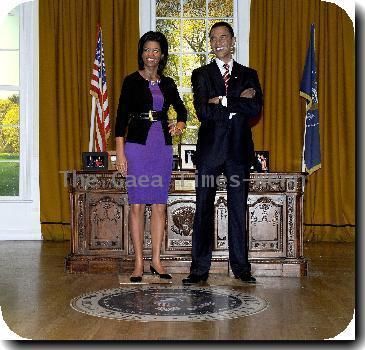New jobless claims, factory order reports disappoint in fresh evidence of an uneven recovery
By Martin Crutsinger, APThursday, January 28, 2010
Jobless claims, durable goods point to weak growth
WASHINGTON — Evidence that the economic rebound remains sluggish emerged from reports Thursday on new claims for unemployment aid and orders to U.S. factories.
The number of people claiming jobless aid fell last week, but less than expected. And orders for big-ticket manufactured goods rose but also fell short of analysts’ predictions.
Weak job creation, in particular, is restraining consumer spending and holding back the economic recovery.
The reports follow President Barack Obama’s State of the Union address Wednesday night, which focused on the economy and jobs. Obama called on Congress to enact a second stimulus package, urging that it contain help for small businesses and funding for infrastructure projects.
Also on Wednesday, the Federal Reserve kept the short-term interest rate it controls at a record-low level of nearly zero and pledged to keep it there for “an extended period.”
The weak economic reports Thursday contributed to a decline on Wall Street. The Dow Jones industrial average closed down about 115 points, or 1.1 percent, and broader stock averages also dropped.
In its report on jobless claims, the Labor Department said first-time claims dropped 8,000 last week to a seasonally adjusted 470,000. Analysts had expected a steeper drop to 450,000, according to Thomson Reuters.
The four week average, which smooths out volatility, rose for the second straight week to 456,250. The average had fallen for 19 straight weeks before starting to rise.
Two weeks ago, claims surged by 34,000 due to administrative backlogs left over from the holidays in the state agencies that process the claims, a Labor Department analyst said. Those delays may still be affecting the data, the analyst said.
That means the current figures could be artificially inflated. At the same time, it would also mean that the steep drop in claims in late December and early January was also exaggerated by the backlogs.
Economists closely watch initial claims as a gauge of the pace of layoffs and a sign of companies’ willingness to hire new workers.
The Commerce Department report on orders to factories for manufactured goods rose 0.3 percent in December. That was far less than the 2 percent advance economists had expected. And for all of 2009, durable goods orders plunged 20.2 percent, the largest drop on records dating to 1992.
The decline highlighted the battering that U.S. manufacturers suffered during the recession, despite signs that manufacturing is recovering gradually.
The report did contain some encouraging news. While overall orders were slowed by lower demand for new aircraft, orders for capital goods —which exclude aircraft and defense spending — rose 1.3 percent. That increase reflected businesses boosting purchases of machinery and equipment.
Capital good spending has risen at an 11 percent rate in the past three months, according to Zach Pandl, an economist at Nomura Securities.
“Solid order growth suggests firms are becoming increasingly confident in the recovery,” Pandl wrote in a note to clients.
The jobless claims figure, though, was a disappointment to many economists because the totals remain above a low point of 430,000 reached in late December.
“We are not likely to see hiring outpace firing by a substantial margin until hiring for the 2010 census ramps up in March,” Diane Swonk, chief economist at Mesirow Financial, wrote in a research note.
The overall economy grew at an annual rate of 2.2 percent in the July-September quarter, the first quarterly gain after four consecutive declines as the country was hit by the worst recession since the 1930s. The government will make its first estimate of fourth-quarter gross domestic product on Friday.
Economists are expecting the report will show gross domestic product, the broadest measure of the economy’s output, grew at a healthy 4.5 percent annual rate in the closing three months of last year. But they expect growth will slip again in future quarters unless consumers begin to grow more confident and start spending at a faster clip.
“The economy … appears to have lost some momentum at the end of the year and is slowing as we move into 2010,” Swonk said. “The recovery remains sub-par at best.”
The Labor Department said earlier this month that employers cut 85,000 jobs in December, after adding 4,000 in November. November’s small increase was the first in nearly two years. The unemployment rate was unchanged at 10 percent.
The number of people continuing to claim benefits, meanwhile, dropped by 57,000 to 4.6 million. Those figures lag behind initial claims by a week. But the continuing claims don’t include millions of people who have used up the regular 26 weeks of benefits typically provided by states, and are receiving extended benefits for up to 73 additional weeks, paid for by the federal government.
More than 5.6 million people were receiving extended benefits in the week ended Jan. 9, the latest data available. That’s about 300,000 fewer than the previous week. All told, more than 10 million people are receiving unemployment assistance.
Some employers are continuing to cut jobs. Home Depot Inc. said Tuesday that it will lay off 1,000 employees. And Wal-Mart Stores Inc. said it will cut 11,200 jobs in its Sam’s Club stores as it outsources product demonstrations.
Tags: Barack Obama, Labor Economy, Manufacturing Sector Performance, North America, Personnel, Recessions And Depressions, Union, United States, Us-economy, Washington






